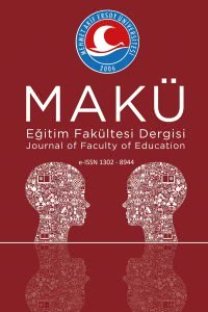Eğitimde Farklılıkların Yönetimi Ölçeğinin Uygulanabilirliği
Bu araştırma, eğitim işgörenlerinin, farklılıkların yönetimine ilişkin algılarını ölçmede kullanılabilecek likert tipi geçerli ve güvenilir bir ölçme aracı geliştirmek amacıyla yapılmıştır. Araştırmanın çalışma grubunu Şanlıurfa ili merkezindeki 224 eğitim işgöreni oluşturmaktadır. Analiz sonuçlarına göre 28 maddeden oluşan Farklılıkların Yönetimi Ölçeği’nin üç faktörlü geçerli ve güvenilir bir ölçme aracı olarak eğitimde kullanılabileceği sonucuna varılmıştır. Analiz sonuçlarına göre ölçeğin, aynı zamanda tek faktörlü olarak kullanılması da olanaklı bulunmuştur.
This research was conducted to develop a valid and reliable likert type scale to measure the perceptions of educational employees towards management of diversity. 224 educational employees working in the centre of Şanlıurfa province constitue the study group of this research. Results of analysis revealed that Management of Diversity Scale which consisted of 28 items is a valid and reliable scale with three factors can be used in education. Results also revealed that it is possible to use the scale as a single factor.
___
Ashkanasy, N. M.; Hartel, C. E. J and Daus, C. S. (2002). Diversity and Emotion: The New Frontiers in Organizational Behavior Research. Journal of Management (28): 3, 307-338.Bhadury, H.; Mighty, E. J. And Damar, H. (2000). Maximizing Workforce Diversity in Project Teams: A Network Flow Approach. The International Journal of Management Science (28): 143-153.
Büyüköztürk, Ş. (2002). Sosyal Bilimler İçin Veri Analizi Elkitabı: İstatistik, Araştırma Deseni SPSS Uygulamaları ve Yorum. Ankara: PegemA Yayıncılık.
Cordero, R.; DiTomaso, N, and Farris, G. F. (Sept 1996). Gender and Race/Ethnic Composition of Technical Work Groups: Relationship to Creative Productivity and Moral. Journal of Engineering and Technology Management (13): 3-4, 205-221.
Cox, T. Jr. (1994). Cultural Diversity in Organizations: Theory, Research and Practice. San Francisco: Brett-Koehler. In McMahan, G. C.; Bell, M. P.; and Virick, M. (1998). Strategic Human Resource Management: Employee Involvement, Diversity, and International Issues. Human Resource Management Review (8): 3, 193-214.
Day, D. V.; Cross Jr, W. E.; Ringseis, E. L and Williams, T. L. (1999). Self-categorization and Identity Construction Associated With Managing Diversity. Journal of Vocational Behaviour (54): 188-195.
Foxman, E and Easterling, D. (May/June 1999). The Representation of Diversity in Marketing Principles Texts: An Exploratory Analysis. Journal of Education for Business 285-288.
Hayes, B.C.; Bartle, S. A and Major, D. A. (2002). Climate for Opportunity: A Conceptual Model. Human Resource Management Review (12): 445-468.
Kepenekçi, Y. K. ( Mart 2000). İnsan Hakları Eğitimine Yönelik Bir Tutum Ölçeği. Eğitim Araştırmaları 51-57.
Kırby, S. L and Richard, O. C. (2000). Impact of Marketing Work-Place Diversity On Employee Job Involvement and Organizational Commitment. The Journal of Social Psychology (140): 3, 367-377.
Loosemore, M and Al Muslmani, H. S. (1999). Construction Project Management in The Persian Gulf: Inter-cultural Communication. International Journal of Project Management (17): 2, 95-100.
Loosemore, M and Lee, P. (2002). Communication Problems With Ethnic Minorities in The Construction Industry. International Journal of Project Management (20): 517-524.
McMahan, G. C.; Bell, M. P.; and Virick, M. (1998). Strategic Human Resource Management: Employee Involvement, Diversity, and International Issues. Human Resource Management Review (8): 3, 193-214.
Mollica, K. A. (2003). The Influence of Diversity Context On White Men’s and Racial Minorities’ Reactions to Disproportionate Group Harm. The Journal of Social Psychology (14): 4, 415-431.
Schermerhon, J. R., Hunt, J. G., And Osborn, R. N. (2000). Organizational Behavior 7th Ed. John Wiley & Sons Inc. New York.
Rosenzweig IMD, P. (1998). Managing The New Global Workforce: Fostering Diversity, Forging Consistency. Europen Management Journal (16): 6, 644-652.
- ISSN: 1302-8944.
- Yayın Aralığı: Yılda 2 Sayı
- Başlangıç: 2018
Sayıdaki Diğer Makaleler
İlköğretim Denetmenlerinin Denetim Süresince Karşılaştıkları Sorunlar
Özel Yetenek Sınavına Giren Lise Öğrencilerinin Kaygı Düzeylerinin İncelenmesi
Bireysel Piyano Eğitiminde Öğretmenin Başarısı
Üniversite Öğrencilerinin "Analiz" Konularındaki Hataları ve Kavram Yanılgıları
Müzik Eğitiminde Online Sistemler ve İnteraktif Yazılımlar
Liselerimizde Uygulanan Coğrafya Öğretim Programının Sorunları ve Çözüm Önerileri
"Çalıkuşu" ve "Yeni Turan" Romanlarındaki Eğitim Felsefesi ve Öğretmen Modeli
Lise 2. Sınıf Öğrencilerinin Manyetizma Kavramlarını Günlük Hayata Uygulama Becerilerinin Tespiti
DİLEK ERDURAN AVCI, Rahmi YAĞBASAN
